外文翻译--生态旅游对环境的影响
- 格式:doc
- 大小:31.00 KB
- 文档页数:4
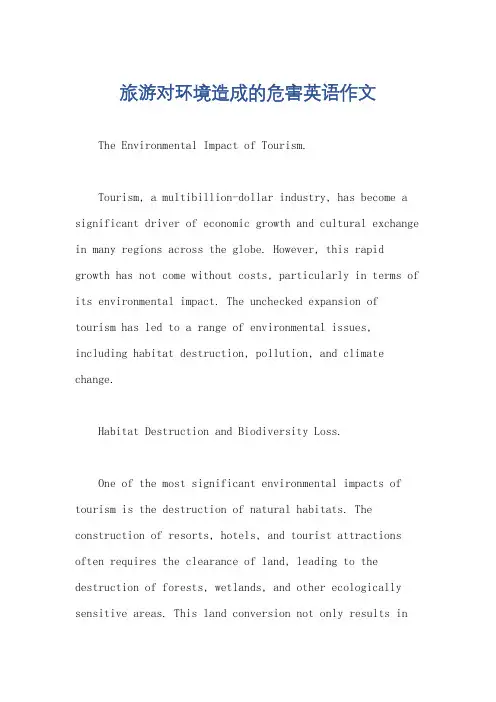
旅游对环境造成的危害英语作文The Environmental Impact of Tourism.Tourism, a multibillion-dollar industry, has become a significant driver of economic growth and cultural exchange in many regions across the globe. However, this rapid growth has not come without costs, particularly in terms of its environmental impact. The unchecked expansion of tourism has led to a range of environmental issues, including habitat destruction, pollution, and climate change.Habitat Destruction and Biodiversity Loss.One of the most significant environmental impacts of tourism is the destruction of natural habitats. The construction of resorts, hotels, and tourist attractions often requires the clearance of land, leading to the destruction of forests, wetlands, and other ecologically sensitive areas. This land conversion not only results inthe loss of biodiversity but also disrupts the ecological balance of the region.For example, in many tropical destinations, theclearing of rainforests for resort development has led to the displacement of indigenous species and the degradationof critical ecosystems. These losses are often irreversible, as many species require specific habitats to survive.Pollution.Tourism also contributes to pollution in various forms. One of the most visible forms is the increase in solidwaste generated by tourists and tourism-related activities. Resorts, restaurants, and other tourist attractionsgenerate large amounts of trash, including plastic, paper, and food waste. This waste often ends up in local landfills or, worse, is dumped illegally, leading to soil and water pollution.In addition, the transportation of tourists andtourism-related goods contributes significantly to airpollution. The increased use of cars, buses, and aircraftfor transportation leads to higher emissions of greenhouse gases and other pollutants, which contribute to climate change and air quality issues.Climate Change.The environmental impacts of tourism are exacerbated by climate change. The tourism industry is a major contributor to greenhouse gas emissions, particularly through the transportation of tourists and goods. As the climate changes, tourism destinations are facing a range of new challenges, including extreme weather events, sea level rise, and changes in temperature and precipitation patterns.These changes not only affect the natural beauty of tourist destinations but also pose safety risks to tourists and local residents. For example, beach erosion andflooding caused by climate change have led to the closureof some popular beaches and resorts.Cultural Impact.Beyond the direct environmental impacts, tourism also has significant cultural impacts on destinations. The commercialization of culture and heritage sites can lead to the loss of authenticity and the exploitation of local traditions for profit. This can erode the cultural identity of communities and lead to a homogenization of cultural experiences, which can be particularly harmful to smaller, less-developed communities.Solutions and Sustainable Tourism.The negative environmental impacts of tourism can be mitigated through sustainable tourism practices.Sustainable tourism emphasizes the need to balance economic, social, and environmental objectives. This includes promoting responsible travel behaviors, such as reducing waste, using renewable energy, and supporting local businesses and communities.Governments and tourism organizations can also play a role in promoting sustainable tourism practices. Policiesthat encourage environmentally responsible development, such as those that promote the use of renewable energy and limit land conversion for tourism development, can help mitigate the negative impacts of tourism.In addition, education and awareness-raising arecrucial for promoting sustainable tourism. By informing tourists and local communities about the environmental and cultural impacts of tourism, we can foster a culture of responsibility and respect for the places we visit.In conclusion, tourism has significant environmental impacts that cannot be ignored. It is crucial that we recognize these impacts and take action to mitigate them through sustainable tourism practices. By doing so, we can ensure that tourism remains a force for positive change, driving economic growth and cultural exchange while protecting the natural and cultural heritage of our planet.。
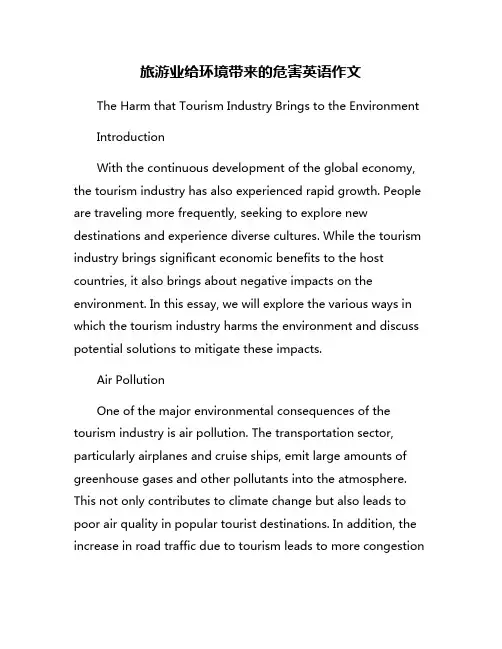
旅游业给环境带来的危害英语作文The Harm that Tourism Industry Brings to the EnvironmentIntroductionWith the continuous development of the global economy, the tourism industry has also experienced rapid growth. People are traveling more frequently, seeking to explore new destinations and experience diverse cultures. While the tourism industry brings significant economic benefits to the host countries, it also brings about negative impacts on the environment. In this essay, we will explore the various ways in which the tourism industry harms the environment and discuss potential solutions to mitigate these impacts.Air PollutionOne of the major environmental consequences of the tourism industry is air pollution. The transportation sector, particularly airplanes and cruise ships, emit large amounts of greenhouse gases and other pollutants into the atmosphere. This not only contributes to climate change but also leads to poor air quality in popular tourist destinations. In addition, the increase in road traffic due to tourism leads to more congestionand emissions of pollutants from vehicles, further exacerbating air pollution.Deforestation and Habitat DestructionAnother significant impact of the tourism industry on the environment is deforestation and habitat destruction. To accommodate the growing number of tourists, infrastructure such as hotels, resorts, and roads are often built in ecologically sensitive areas. This results in the destruction of forests, wetlands, and other natural habitats, leading to loss of biodiversity and disruption of ecosystems. Additionally, recreational activities such as hiking, skiing, and scuba diving can have negative impacts on fragile ecosystems and wildlife.Water PollutionTourism also contributes to water pollution through various activities such as sewage discharge, littering, and use of chemicals in hotels and resorts. In coastal areas, pollution from cruise ships and recreational boats can harm marine life and coral reefs. Moreover, the construction of resorts and golf courses often involves the clearing of land and alteration of waterways, which can lead to sedimentation, nutrient runoff, and pollution of water bodies.Waste GenerationThe tourism industry generates a significant amount of waste, including food waste, plastic bottles, packaging materials, and other disposable items. In many developing countries, waste management infrastructure is inadequate to handle the influx of tourists, leading to littering, illegal dumping, and pollution of land and water bodies. Plastic pollution, in particular, poses a major threat to marine life, as it can be ingested by animals or entangle them, causing injury or death.Overcrowding and OvertourismOvertourism is a growing problem in many popular destinations, as the sheer number of tourists overwhelms local resources and infrastructure. This leads to overcrowding, congestion, noise pollution, and degradation of cultural heritage sites. In addition, the influx of tourists can disrupt the lives of local communities, drive up prices, and strain social services. Overtourism also puts pressure on natural attractions, leading to degradation of ecosystems and loss of authenticity.SolutionsTo address the environmental impacts of the tourism industry, it is essential for governments, businesses, and touriststo take proactive measures to promote sustainable tourism practices. Some potential solutions include:1. Implementing eco-friendly transportation options, such as electric buses, bicycles, and trains, to reduce emissions and congestion.2. Encouraging the use of renewable energy sources, such as solar and wind power, in hotels and resorts to minimize carbon footprint.3. Adopting water conservation measures, such as rainwater harvesting and greywater recycling, to reduce water consumption and pollution.4. Promoting waste reduction and recycling programs in tourist areas to minimize the generation of waste and prevent littering.5. Establishing carrying capacity limits for popular tourist destinations to prevent overcrowding and protect natural and cultural resources.ConclusionIn conclusion, while the tourism industry brings economic benefits and cultural exchange opportunities, it also has significant negative impacts on the environment. From airpollution and deforestation to water pollution and waste generation, the tourism industry contributes to a wide range of environmental problems. It is crucial for all stakeholders to work together to promote sustainable tourism practices and minimize the harm caused to the environment. By implementingeco-friendly measures and fostering responsible tourism behavior, we can ensure that future generations will be able to enjoy and benefit from the wonders of the natural world.。
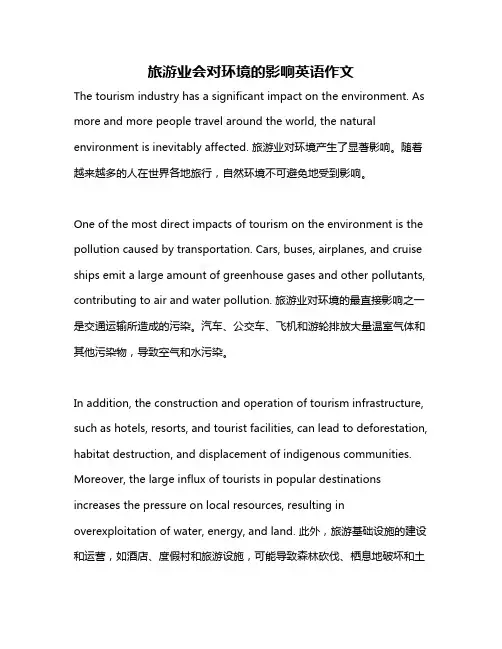
旅游业会对环境的影响英语作文The tourism industry has a significant impact on the environment. As more and more people travel around the world, the natural environment is inevitably affected. 旅游业对环境产生了显著影响。
随着越来越多的人在世界各地旅行,自然环境不可避免地受到影响。
One of the most direct impacts of tourism on the environment is the pollution caused by transportation. Cars, buses, airplanes, and cruise ships emit a large amount of greenhouse gases and other pollutants, contributing to air and water pollution. 旅游业对环境的最直接影响之一是交通运输所造成的污染。
汽车、公交车、飞机和游轮排放大量温室气体和其他污染物,导致空气和水污染。
In addition, the construction and operation of tourism infrastructure, such as hotels, resorts, and tourist facilities, can lead to deforestation, habitat destruction, and displacement of indigenous communities. Moreover, the large influx of tourists in popular destinations increases the pressure on local resources, resulting in overexploitation of water, energy, and land. 此外,旅游基础设施的建设和运营,如酒店、度假村和旅游设施,可能导致森林砍伐、栖息地破坏和土著社区的迁徙。
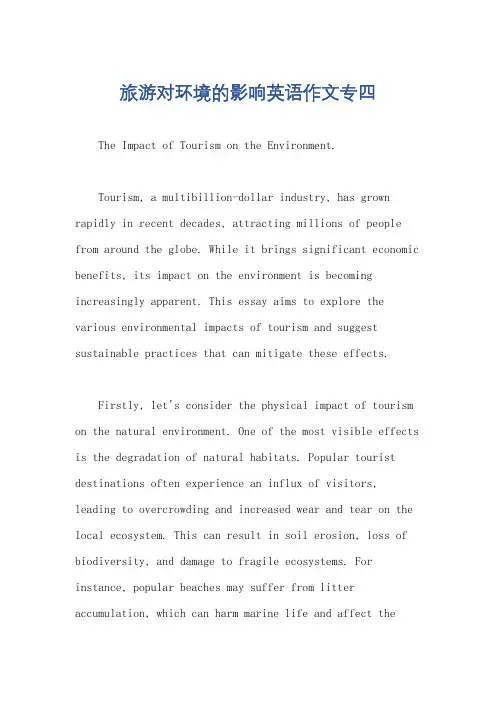
旅游对环境的影响英语作文专四The Impact of Tourism on the Environment.Tourism, a multibillion-dollar industry, has grown rapidly in recent decades, attracting millions of people from around the globe. While it brings significant economic benefits, its impact on the environment is becoming increasingly apparent. This essay aims to explore the various environmental impacts of tourism and suggest sustainable practices that can mitigate these effects.Firstly, let's consider the physical impact of tourism on the natural environment. One of the most visible effects is the degradation of natural habitats. Popular tourist destinations often experience an influx of visitors, leading to overcrowding and increased wear and tear on the local ecosystem. This can result in soil erosion, loss of biodiversity, and damage to fragile ecosystems. For instance, popular beaches may suffer from litter accumulation, which can harm marine life and affect theoverall health of the ocean ecosystem.Moreover, the construction of hotels, resorts, and other tourist infrastructure often requires the clearing of land, leading to the destruction of valuable habitats. This process can displace wildlife, disrupt ecological balance, and contribute to climate change through deforestation and the release of greenhouse gases.Another significant impact of tourism is the increasein water consumption and waste generation. Tourist destinations often face a surge in demand for water, leading to overexploitation and depletion of local water resources. Additionally, the influx of tourists generates a large amount of solid waste, which can contaminate soil and water bodies, affecting the health of local communities and ecosystems.Moreover, tourism can have a negative impact oncultural heritage. The influx of tourists can lead to the commercialization of local culture, eroding itsauthenticity and value. This can result in the loss oftraditional practices, languages, and art forms, which are integral to the identity and heritage of a place.To mitigate these negative impacts, it is crucial to adopt sustainable tourism practices. One effective strategy is to promote eco-tourism, which focuses on protecting the environment and supporting local communities. Eco-tourism activities, such as wildlife observation, hiking, and cultural immersion, allow tourists to experience thenatural and cultural beauty of a place while minimizingtheir impact.Additionally, it is essential to encourage tourism operators to adopt sustainable practices, such as water conservation, waste reduction, and energy efficiency. This can be achieved through policies and incentives that reward sustainable behavior and penalize environmental degradation.Furthermore, community engagement and participation are crucial for sustainable tourism. Local communities shouldbe involved in decision-making processes and benefit from tourism activities. This can be achieved throughpartnerships with local organizations, community-based tourism initiatives, and the promotion of local products and services.In conclusion, tourism has a significant impact on the environment, affecting both natural and cultural resources. To ensure the long-term sustainability of tourism, it is crucial to adopt sustainable practices and involve local communities in decision-making. By doing so, we can ensure that tourism benefits not only the economy but also the environment and local communities.。
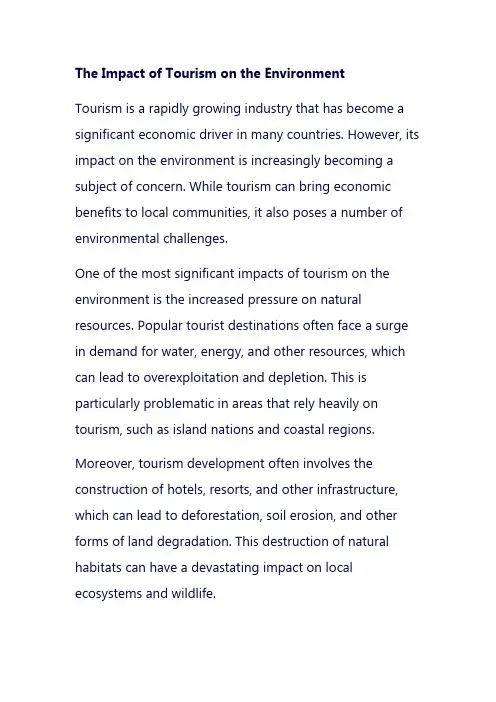
The Impact of Tourism on the EnvironmentTourism is a rapidly growing industry that has become a significant economic driver in many countries. However, its impact on the environment is increasingly becoming a subject of concern. While tourism can bring economic benefits to local communities, it also poses a number of environmental challenges.One of the most significant impacts of tourism on the environment is the increased pressure on natural resources. Popular tourist destinations often face a surge in demand for water, energy, and other resources, which can lead to overexploitation and depletion. This is particularly problematic in areas that rely heavily on tourism, such as island nations and coastal regions. Moreover, tourism development often involves the construction of hotels, resorts, and other infrastructure, which can lead to deforestation, soil erosion, and other forms of land degradation. This destruction of natural habitats can have a devastating impact on local ecosystems and wildlife.Another environmental challenge posed by tourism is the increased level of pollution. Tourism activities, such as transportation, accommodation, and entertainment, often generate significant amounts of waste and emissions. This can include solid waste, wastewater, and air pollution, all of which can have negative effects on the local environment and human health.In addition, tourism can also lead to the introduction of non-native species and the spread of diseases. Visitors from other regions can bring with them plants, animals, and pathogens that can disrupt local ecosystems and pose risks to native species. This can have long-term consequences for the biodiversity of a region. However, it is important to note that tourism can also be a force for positive environmental change. Sustainable tourism practices, such as eco-tourism and green tourism, can help protect natural resources and promote environmental conservation. These practices aim to minimize the negative impacts of tourism while maximizing its positive economic and social benefits.In conclusion, the impact of tourism on the environment is complex and multifaceted. While it can bring significant economic benefits to local communities, it also poses a number of environmental challenges. It is crucial for policymakers, tourism operators, and visitors to take steps to minimize the negative impacts of tourism while promoting sustainable practices that protect our natural resources and ecosystems.。
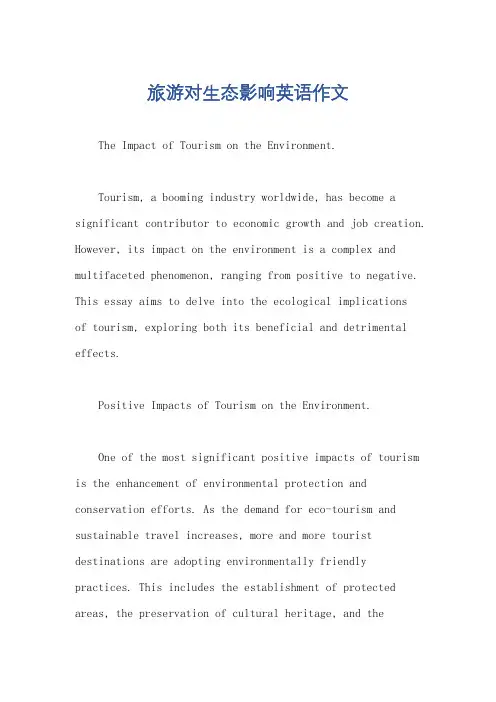
旅游对生态影响英语作文The Impact of Tourism on the Environment.Tourism, a booming industry worldwide, has become a significant contributor to economic growth and job creation. However, its impact on the environment is a complex and multifaceted phenomenon, ranging from positive to negative. This essay aims to delve into the ecological implicationsof tourism, exploring both its beneficial and detrimental effects.Positive Impacts of Tourism on the Environment.One of the most significant positive impacts of tourism is the enhancement of environmental protection and conservation efforts. As the demand for eco-tourism and sustainable travel increases, more and more tourist destinations are adopting environmentally friendly practices. This includes the establishment of protected areas, the preservation of cultural heritage, and thepromotion of sustainable tourism products and services.Protected areas, such as national parks and wildlife reserves, often receive funding from tourism revenues. This funding is then used for conservation efforts, including the protection of endangered species, the restoration of habitats, and the prevention of illegal activities like poaching and logging. In addition, the presence of tourists in these areas often raises.。
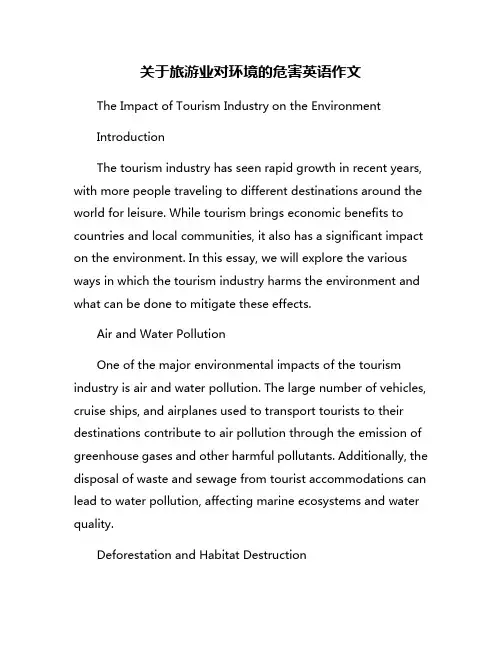
关于旅游业对环境的危害英语作文The Impact of Tourism Industry on the EnvironmentIntroductionThe tourism industry has seen rapid growth in recent years, with more people traveling to different destinations around the world for leisure. While tourism brings economic benefits to countries and local communities, it also has a significant impact on the environment. In this essay, we will explore the various ways in which the tourism industry harms the environment and what can be done to mitigate these effects.Air and Water PollutionOne of the major environmental impacts of the tourism industry is air and water pollution. The large number of vehicles, cruise ships, and airplanes used to transport tourists to their destinations contribute to air pollution through the emission of greenhouse gases and other harmful pollutants. Additionally, the disposal of waste and sewage from tourist accommodations can lead to water pollution, affecting marine ecosystems and water quality.Deforestation and Habitat DestructionThe construction of hotels, resorts, and infrastructure to support the tourism industry often leads to deforestation and habitat destruction. In order to build these facilities, large areas of land are cleared, destroying natural habitats for plants and animals. This loss of biodiversity can have long-term consequences for ecosystems and the overall health of the environment.Resource DepletionTourism also puts a significant strain on natural resources such as water, energy, and food. The high demand for these resources by tourists and the infrastructure that supports them can lead to overuse and depletion of local resources. This can have negative consequences on the environment, such as water scarcity, energy shortages, and food insecurity.Climate ChangeThe tourism industry is a major contributor to climate change, mainly due to the emission of greenhouse gases from transportation and accommodation facilities. The increasing number of tourists traveling to far-flung destinations by airplane leads to a rise in carbon emissions, which contributes to global warming and other climate-related issues. The impacts of climate change, such as rising sea levels, extreme weather events, andloss of biodiversity, can have devastating effects on the environment and local communities.SolutionsIn order to minimize the negative impacts of the tourism industry on the environment, several measures can be taken:1. Sustainable Tourism Practices: Encouraging sustainable tourism practices such as eco-friendly accommodations, responsible wildlife viewing, and conservation efforts can help reduce the environmental footprint of the tourism industry.2. Transportation Alternatives: Promoting alternative modes of transportation such as public transit, cycling, and walking can help reduce greenhouse gas emissions and air pollution from vehicles.3. Waste Management: Implementing effective waste management practices, such as recycling and waste reduction programs, can help minimize the amount of waste generated by tourists and accommodations.4. Conservation and Preservation: Supporting conservation and preservation efforts for natural habitats and biodiversity can help protect the environment from the negative impacts of tourism.ConclusionThe tourism industry has a significant impact on the environment, contributing to air and water pollution, deforestation, resource depletion, and climate change. By implementing sustainable practices and conservation efforts, we can help mitigate the negative effects of tourism on the environment and ensure a more sustainable future for both the tourism industry and the planet. It is important for governments, businesses, and tourists to work together to promote responsible tourism practices that protect the environment for future generations.。
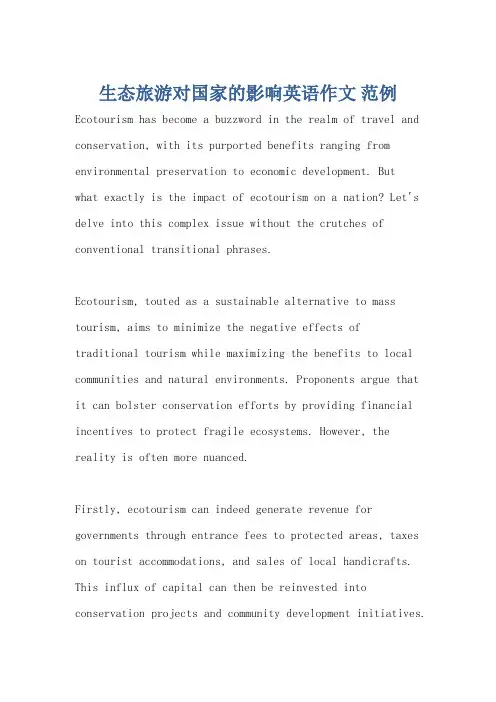
生态旅游对国家的影响英语作文范例Ecotourism has become a buzzword in the realm of travel and conservation, with its purported benefits ranging from environmental preservation to economic development. Butwhat exactly is the impact of ecotourism on a nation? Let's delve into this complex issue without the crutches of conventional transitional phrases.Ecotourism, touted as a sustainable alternative to mass tourism, aims to minimize the negative effects oftraditional tourism while maximizing the benefits to local communities and natural environments. Proponents argue that it can bolster conservation efforts by providing financial incentives to protect fragile ecosystems. However, thereality is often more nuanced.Firstly, ecotourism can indeed generate revenue for governments through entrance fees to protected areas, taxes on tourist accommodations, and sales of local handicrafts. This influx of capital can then be reinvested into conservation projects and community development initiatives.Additionally, by creating jobs in rural areas, ecotourism can alleviate poverty and reduce pressure on natural resources, thus contributing to long-term sustainability.However, the implementation of ecotourism is not withoutits challenges. The influx of visitors, even if they are environmentally conscious, can still disturb delicate ecosystems and wildlife habitats. Trails may erode, waste may accumulate, and wildlife may become habituated to human presence, altering their natural behaviors. Moreover, the commodification of nature can lead to cultural commodification and the marginalization of indigenous communities.Furthermore, the emphasis on profit can sometimes overshadow conservation goals, leading to "greenwashing" –the practice of presenting a superficially eco-friendly image while prioritizing economic gains over environmental protection. This can result in the exploitation of natural resources, displacement of local populations, and degradation of ecosystems in the name of tourism development.Despite these challenges, ecotourism holds the potential to foster greater environmental awareness and appreciation among travelers. Through guided tours and educational programs, visitors can learn about the importance of biodiversity and the need for conservation efforts. This increased awareness may translate into support for conservation policies and initiatives both domestically and internationally.In conclusion, the impact of ecotourism on a nation is multifaceted and complex. While it has the potential to bring economic benefits and support conservation efforts, it also poses challenges to environmental integrity and cultural preservation. To truly harness the potential of ecotourism, governments, businesses, and communities must work together to prioritize sustainability, equity, and environmental stewardship. Only then can ecotourism realize its promise as a force for positive change in the world.。
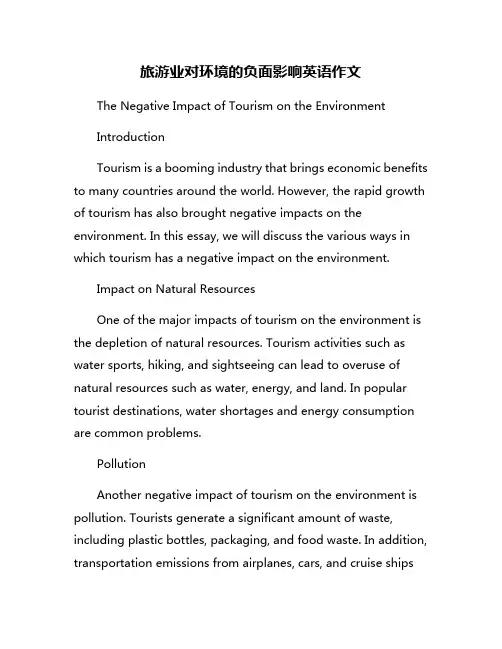
旅游业对环境的负面影响英语作文The Negative Impact of Tourism on the EnvironmentIntroductionTourism is a booming industry that brings economic benefits to many countries around the world. However, the rapid growth of tourism has also brought negative impacts on the environment. In this essay, we will discuss the various ways in which tourism has a negative impact on the environment.Impact on Natural ResourcesOne of the major impacts of tourism on the environment is the depletion of natural resources. Tourism activities such as water sports, hiking, and sightseeing can lead to overuse of natural resources such as water, energy, and land. In popular tourist destinations, water shortages and energy consumption are common problems.PollutionAnother negative impact of tourism on the environment is pollution. Tourists generate a significant amount of waste, including plastic bottles, packaging, and food waste. In addition, transportation emissions from airplanes, cars, and cruise shipscontribute to air pollution and greenhouse gas emissions. These pollutants can have detrimental effects on the local ecosystem and wildlife.Habitat DestructionTourism development often leads to habitat destruction and fragmentation. Resorts, hotels, and tourist infrastructure are built in ecologically sensitive areas such as beaches, forests, and wetlands, leading to loss of habitat for native species. This can result in the decline of biodiversity and disrupt the delicate balance of the ecosystem.Cultural ImpactThe influx of tourists can also have a negative impact on the local culture and traditions of a destination. As tourist numbers increase, local communities may feel pressure to cater to the needs of tourists and abandon their traditional way of life. This can lead to the loss of cultural identity and heritage.OvertourismOvertourism is another major issue facing many popular tourist destinations. Overtourism occurs when there are too many tourists in a destination, leading to overcrowding, traffic congestion, and strain on local infrastructure. This can have anegative impact on the quality of life for residents and degrade the visitor experience.ConclusionIn conclusion, while tourism brings economic benefits to many countries, it also has a significant negative impact on the environment. From depletion of natural resources to pollution, habitat destruction, and cultural impact, the negative consequences of tourism on the environment are undeniable. It is important for governments, businesses, and tourists to take responsibility for their actions and adopt sustainable practices to minimize the negative impact of tourism on the environment. Only by working together can we ensure that tourism remains a sustainable and responsible industry for generations to come.。
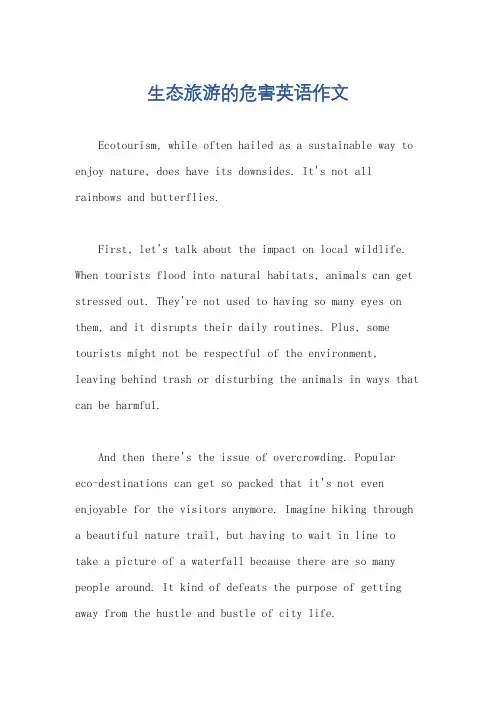
生态旅游的危害英语作文Ecotourism, while often hailed as a sustainable way to enjoy nature, does have its downsides. It's not all rainbows and butterflies.First, let's talk about the impact on local wildlife. When tourists flood into natural habitats, animals can get stressed out. They're not used to having so many eyes on them, and it disrupts their daily routines. Plus, some tourists might not be respectful of the environment, leaving behind trash or disturbing the animals in ways that can be harmful.And then there's the issue of overcrowding. Populareco-destinations can get so packed that it's not even enjoyable for the visitors anymore. Imagine hiking through a beautiful nature trail, but having to wait in line to take a picture of a waterfall because there are so many people around. It kind of defeats the purpose of getting away from the hustle and bustle of city life.Not to mention, ecotourism can also lead to gentrification of local communities. As tourism increases, prices go up, and the locals who have lived there for generations might not be able to afford to stay. It's sad to see the culture and traditions of a place get diluted because of tourism.So, yeah, ecotourism has its pros and cons. Sure, it can bring awareness and money to.。
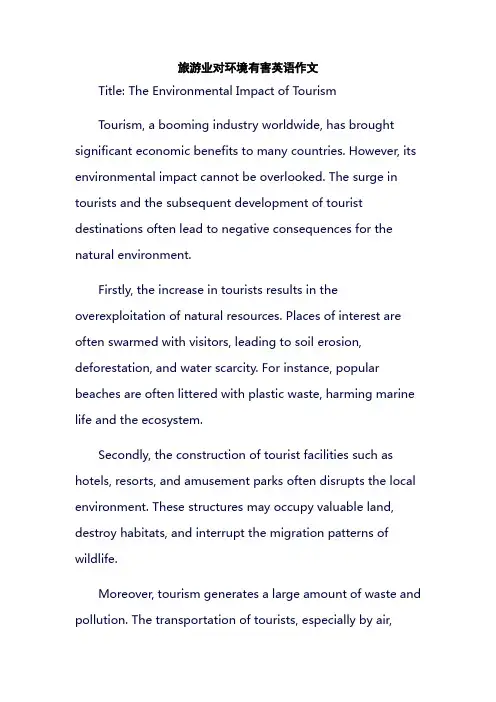
旅游业对环境有害英语作文Title: The Environmental Impact of TourismTourism, a booming industry worldwide, has brought significant economic benefits to many countries. However, its environmental impact cannot be overlooked. The surge in tourists and the subsequent development of tourist destinations often lead to negative consequences for the natural environment.Firstly, the increase in tourists results in the overexploitation of natural resources. Places of interest are often swarmed with visitors, leading to soil erosion, deforestation, and water scarcity. For instance, popular beaches are often littered with plastic waste, harming marine life and the ecosystem.Secondly, the construction of tourist facilities such as hotels, resorts, and amusement parks often disrupts the local environment. These structures may occupy valuable land, destroy habitats, and interrupt the migration patterns of wildlife.Moreover, tourism generates a large amount of waste and pollution. The transportation of tourists, especially by air,contributes significantly to greenhouse gas emissions. Additionally, the daily activities of tourists, such as eating and shopping, generate waste that is often not properly disposed of.It is, therefore, crucial for tourism to be sustainable. Measures should be taken to minimize the environmental impact of tourism, such as promoting eco-friendly practices, limiting the number of tourists in certain areas, and enforcing strict environmental regulations.In conclusion, while tourism brings economic prosperity, it also poses significant threats to the environment. It is essential for us to strike a balance between economic growth and environmental protection, ensuring that tourism remains a viable and sustainable industry.。
英语作文旅游业对环境Title: The Environmental Impact of Tourism。
Tourism has become a significant global industry, contributing to economic growth and cultural exchange. However, alongside its benefits, tourism also poses challenges to the environment. In this essay, we will explore the environmental impact of tourism and discuss measures to mitigate its negative effects.Firstly, one of the most apparent environmental impacts of tourism is pollution. The influx of tourists to popular destinations leads to increased waste generation, including plastic bottles, packaging materials, and other non-biodegradable items. This pollution not only degrades the aesthetic appeal of natural landscapes but also harms wildlife and marine ecosystems. For instance, marine animals often mistake plastic debris for food, leading to ingestion and entanglement, which can be fatal.Moreover, tourism activities often contribute tohabitat destruction and biodiversity loss. The construction of resorts, hotels, and infrastructure projects in ecologically sensitive areas can result in deforestation, habitat fragmentation, and displacement of native species. Additionally, activities such as hiking, camping, and off-road driving can cause soil erosion and damage fragile ecosystems, threatening the survival of endemic flora and fauna.Furthermore, tourism can exacerbate water scarcity and pollution in destination areas. Large-scale resorts and tourist facilities consume significant amounts of water for swimming pools, landscaping, and other amenities, placing pressure on local water resources, particularly in arid regions. Additionally, improper waste management practices, such as untreated sewage discharge and chemical runoff from resorts, can contaminate rivers, lakes, and coastal waters, jeopardizing the health of aquatic ecosystems and human communities.To address these environmental challenges, stakeholdersin the tourism industry must adopt sustainable practices that minimize negative impacts and promote conservation efforts. One approach is to implement eco-friendly tourism initiatives, such as eco-lodges, wildlife sanctuaries, and nature reserves, that prioritize environmental protection and cultural preservation. These initiatives not only contribute to biodiversity conservation but also offer tourists authentic and immersive experiences in natural settings.Furthermore, promoting responsible tourism behavior among travelers is crucial for minimizing environmental degradation. Education and awareness campaigns can raise tourists' consciousness about the importance of respecting local ecosystems, conserving resources, and minimizing waste generation. Encouraging practices such as waste reduction, recycling, and using eco-friendly transportation options can significantly reduce the carbon footprint of tourism activities.Additionally, governments and regulatory authorities play a vital role in enforcing environmental regulationsand promoting sustainable tourism development. Implementing zoning laws, environmental impact assessments, and carrying capacity limits can help prevent overdevelopment andprotect fragile ecosystems from excessive tourist pressure. Furthermore, incentivizing businesses to adopt green certification programs and providing financial support for eco-friendly initiatives can stimulate sustainable tourism practices.In conclusion, while tourism offers significant economic benefits and cultural exchange opportunities, it also poses significant environmental challenges. To ensure the long-term sustainability of the tourism industry, stakeholders must prioritize environmental conservation and adopt sustainable practices that minimize negative impacts on natural ecosystems. By promoting eco-friendly tourism initiatives, educating travelers about responsible behavior, and enforcing environmental regulations, we can mitigatethe environmental impact of tourism and preserve ourplanet's precious natural heritage for future generations.。
旅游会对环境带来危害吗英语作文The Impact of Tourism on the EnvironmentTourism is a booming industry that brings economic benefits to many destinations around the world. However, the environmental impact of tourism is a growing concern. As more and more people travel to popular destinations, the natural environment is often put at risk. In this essay, we will explore the ways in which tourism can harm the environment and discuss some possible solutions to mitigate these impacts.One of the most significant ways in which tourism can harm the environment is through the depletion of natural resources. Popular tourist destinations often see an increase in demand for water, energy, and other resources, which can put a strain on local ecosystems. For example, increased water consumption by hotels and resorts can lead to water shortages for local communities and damage fragile ecosystems such as coral reefs. Additionally, the construction of new infrastructure, such as hotels and airports, can contribute to deforestation and habitat loss for wildlife.Another environmental issue caused by tourism is pollution. Tourists often generate large amounts of waste, including plasticbottles, food packaging, and other disposable items. Improper disposal of this waste can contaminate water sources, harm wildlife, and degrade scenic landscapes. In addition, the transportation methods used by tourists, such as airplanes and cruise ships, can contribute to air and noise pollution, as well as greenhouse gas emissions that contribute to climate change.The impact of tourism on the environment is not limited to physical damage. Tourism can also have social and cultural impacts on local communities. The influx of tourists can lead to overcrowding, increased traffic congestion, and higher prices for goods and services, which can displace local residents and alter the traditional way of life. Furthermore, the commodification of culture and heritage sites to cater to tourist demand can lead to the loss of authenticity and cultural erosion.Despite these negative impacts, there are ways in which tourism can be made more sustainable and environmentally friendly. One approach is to promote responsible tourism practices, such as reducing waste, conserving water and energy, and supporting local businesses and communities. Governments and tourism operators can also implement regulations and incentives to encourage sustainable practices, such aseco-friendly accommodations, transportation options, and wastemanagement systems. In addition, education and awareness campaigns can help to inform tourists about the environmental impact of their activities and encourage them to make more sustainable choices.In conclusion, tourism can have a significant impact on the environment, but with proper planning and management, these negative impacts can be minimized. By promoting sustainable tourism practices and working together to protect the natural and cultural heritage of our destinations, we can ensure that future generations can continue to enjoy the beauty and diversity of the world.。
旅游业对环境的影响英语作文措施The Impact of Tourism on the Environment and Measures to Mitigate Its Effects.Tourism, a multibillion-dollar industry, has witnessed exponential growth in recent decades. Its far-reaching effects extend beyond the economic realm, encompassing cultural, social, and environmental aspects as well. While tourism can bring immense benefits to local communities, such as job creation and cultural exchange, its environmental impacts are often overlooked. This paper aims to delve into the environmental consequences of tourism and suggest sustainable measures to mitigate its negative effects.Environmental Impacts of Tourism.The environmental impacts of tourism are diverse and often complex. Here are some of the key areas affected:1. Biodiversity Loss.One of the most significant impacts of tourism is the loss of biodiversity. The influx of tourists can disturb natural habitats, leading to the displacement or even extinction of native species. For instance, coral reefs, a popular tourist destination, are often damaged by anchoring boats and snorkeling activities, affecting marine life.2. Ecosystem Degradation.Tourism-related activities such as construction, infrastructure development, and increased waste generation can lead to the degradation of ecosystems. These activities can disrupt natural water cycles, soil fertility, and nutrient cycles, affecting the overall health of the environment.3. Climate Change.The tourism industry contributes significantly to climate change. Transportation, accommodation, and otherassociated activities generate carbon emissions, adding to the greenhouse gas load in the atmosphere. This contributes to global warming and climate change, affecting weather patterns, sea levels, and biodiversity.4. Resource Overexploitation.Tourist destinations often face the problem of resource overexploitation. Natural resources like water, fuel, and food are consumed at unsustainable rates to cater to the needs of the influx of tourists. This can lead to resource depletion and environmental degradation.Measures to Mitigate Environmental Impacts of Tourism.To ensure that tourism is sustainable and does not harm the environment, the following measures can be implemented:1. Ecotourism.Ecotourism is a form of tourism that focuses on responsible travel to natural areas, conserving theenvironment and improving the well-being of local people. It promotes sustainable practices such as minimizing environmental impact, respecting local cultures, and involving local communities in tourism activities. Encouraging ecotourism can help reduce the negative impacts of traditional tourism and promote conservation efforts.2. Green Infrastructure.Developing green infrastructure, such as energy-efficient buildings, renewable energy sources, and water-saving measures, can help reduce the environmentalfootprint of tourism. These measures can be implemented in hotels, resorts, and other tourism-related facilities to reduce carbon emissions, water consumption, and waste generation.3. Waste Management.Effective waste management is crucial to mitigating the environmental impacts of tourism. Implementing waste segregation, recycling, and composting programs can helpreduce the amount of waste generated and its impact on the environment. Additionally, promoting the use of reusable items, such as water bottles and bags, can further reduce waste generation.4. Capacity Planning.Capacity planning involves limiting the number of tourists visiting a destination to ensure that it does not exceed its carrying capacity. This can help protect natural resources and ecosystems from overexploitation and ensure that local communities and the environment can cope with the influx of tourists.5. Community Engagement.Engaging local communities in tourism development and decision-making processes can help ensure that their interests and concerns are addressed. This can lead to more sustainable tourism practices that benefit both the environment and local communities.6. Education and Awareness.Raising awareness among tourists and local communities about the environmental impacts of tourism and promoting sustainable travel practices can help mitigate its negative effects. Educational programs and campaigns can inform people about responsible travel behaviors, such as reducing carbon emissions, conserving water, and respecting local cultures and ecosystems.Conclusion.In conclusion, tourism has both positive and negative impacts on the environment. To ensure that its benefits outweigh its costs, it is crucial to implement sustainable practices and measures to mitigate its negative impacts. By promoting ecotourism, developing green infrastructure, implementing waste management programs, planning capacity, engaging local communities, and educating people about responsible travel behaviors, we can ensure that tourism remains a force for positive change in our world.。
关于旅游业对环境的危害英语作文The tourism industry has both positive and negative impacts on the environment. On one hand, it brings economic benefits to local communities through job creation and infrastructure development. On the other hand, the influx of tourists can lead to environmental degradation and the depletion of natural resources.旅游业对环境有着积极和消极的影响。
一方面,它通过创造就业机会和基础设施发展为当地社区带来经济利益。
另一方面,大量游客的涌入可能导致环境退化和自然资源枯竭。
One of the main environmental concerns associated with tourism is the impact on fragile ecosystems and wildlife habitats. Popular tourist destinations often face challenges such as deforestation, habitat destruction, and pollution, which can threaten the biodiversity of an area.与旅游业相关的主要环境问题之一是对脆弱生态系统和野生动物栖息地的影响。
受欢迎的旅游目的地经常面临着森林砍伐、栖息地破坏和污染等挑战,这可能威胁到一个地区的生物多样性。
Additionally, the transportation and accommodation facilities required to support tourism often contribute to carbon emissionsand air pollution. The increase in vehicular traffic in tourist areas can lead to congestion and increased greenhouse gas emissions, further exacerbating climate change.此外,为支持旅游业所需的交通和住宿设施往往会导致碳排放和空气污染。
关于旅游业对环境的危害英语作文英文回答:The tourism industry has undoubtedly brought numerous benefits to economies around the world, but it also poses significant threats to the environment. The environmental harm caused by tourism can be seen in various aspects.Firstly, the construction of tourist facilities and infrastructure often leads to deforestation and habitat destruction. In order to accommodate the increasing number of tourists, hotels, resorts, and other tourist attractions are built, resulting in the clearance of natural vegetation and the displacement of wildlife. For example, the construction of ski resorts in mountainous areas may require the removal of forests, which not only destroys the natural habitat of many species but also contributes tosoil erosion and water pollution.Secondly, the transportation sector of the tourismindustry is a major contributor to carbon emissions and air pollution. Airplanes, cruise ships, and buses are commonly used by tourists to travel to their destinations, and these modes of transportation consume large amounts of fossil fuels. The emissions from these vehicles contribute toglobal warming and air pollution. For instance, the exhaust fumes released by cruise ships can harm marine life and degrade the air quality in coastal areas.Furthermore, the excessive consumption of resources by tourists also poses a threat to the environment. Tourists often demand luxurious accommodations, which require large amounts of water and energy for operation. Additionally, tourists generate significant amounts of waste, including plastic bottles, food packaging, and other disposable items. Improper disposal of these wastes can lead to pollution of water bodies and damage to ecosystems. For example, popular tourist destinations such as beaches and national parksoften suffer from littering and improper waste management, which negatively impact the local environment.中文回答:旅游业无疑给全球经济带来了许多好处,但也对环境造成了重大威胁。
生态旅游对环境的影响(节选)原文来源:Environment Impacts of Ecotourism;Edited by Ralf BuckleyInternational Centre for Ecotourism Research,Griffith University,AustraliaCAIB Publishing;Oct,2008生态旅游由于其实际或潜在的积极影响受到社会和保护区以及公司和消费者广泛吹捧。
例如,在讨论进入保护区方面,旅游说客和生态旅游经营者宣称他们不仅将会采取措施师环境影响减到最小,而且生态旅游还会产生利益。
然而,保护区也为旅游业提供了非常重要的好处。
每年被人类消耗或污染的自然资源有很多。
人类生存需要饮用水,可呼吸的空气和可用的生物多样性。
自然生态系统是每个这些领域的主要的蓄水池。
生态系统由于人类活动已被不同程度地广泛地修改了。
近原始的荒野地区和其他小改造的地区的环境正在不断减少,像城市中心,垃圾堆放场,矿场和单一种植区几乎完全修改的环境在继续扩大。
有很多没有完全修改而又很重要的地方,如农村住宅,布罗德埃克牧区和被采伐的原始森林在最少修改的地区也继续扩大。
为制止和扭转这些趋势,只在人类的社会结构和人类行为发生大规模和深远的变化时才能成为可能。
然而,如果在短期内没有这种变化,规模更大的混乱将逼近人类。
关于可持续能力和关乎人类生存的任何长期策略唯一最重要的组分,能够使世界各种各样的生态系统的代表性区域保持在一个合理的原封不动的和功能的状态。
当然,这是保护区全局系统的主要目标,包括世界遗产地区、生物圈储备、国家公园和其他保护区域。
然而,这些公园还不能独自地防止生物多样性持续损失:首先,因为他们是太小和不充分地代表性的;第二,因为他们不充分地被保护。
目前,有公开和私有土地其他地区在被保护区系统之外的,它们对保护生物多样性和空气和水的质量有很大贡献。
它们包括:像极地,高山,沙漠和海洋生态系一样很少人的地方;那些为木材和家畜产品使用的但其中很少使用牧场保留其原有的性质功能和生物多样性的森林地和牧场;人类的生活方式没有介入对自然环境的密集的修改的部族和社区土地。
生态旅游对环境的影响(节选)原文来源:Environment Impacts of Ecotourism;Edited by Ralf BuckleyInternational Centre for Ecotourism Research,Griffith University,AustraliaCAIB Publishing;Oct,2008生态旅游由于其实际或潜在的积极影响受到社会和保护区以及公司和消费者广泛吹捧。
例如,在讨论进入保护区方面,旅游说客和生态旅游经营者宣称他们不仅将会采取措施师环境影响减到最小,而且生态旅游还会产生利益。
然而,保护区也为旅游业提供了非常重要的好处。
每年被人类消耗或污染的自然资源有很多。
人类生存需要饮用水,可呼吸的空气和可用的生物多样性。
自然生态系统是每个这些领域的主要的蓄水池。
生态系统由于人类活动已被不同程度地广泛地修改了。
近原始的荒野地区和其他小改造的地区的环境正在不断减少,像城市中心,垃圾堆放场,矿场和单一种植区几乎完全修改的环境在继续扩大。
有很多没有完全修改而又很重要的地方,如农村住宅,布罗德埃克牧区和被采伐的原始森林在最少修改的地区也继续扩大。
为制止和扭转这些趋势,只在人类的社会结构和人类行为发生大规模和深远的变化时才能成为可能。
然而,如果在短期内没有这种变化,规模更大的混乱将逼近人类。
关于可持续能力和关乎人类生存的任何长期策略唯一最重要的组分,能够使世界各种各样的生态系统的代表性区域保持在一个合理的原封不动的和功能的状态。
当然,这是保护区全局系统的主要目标,包括世界遗产地区、生物圈储备、国家公园和其他保护区域。
然而,这些公园还不能独自地防止生物多样性持续损失:首先,因为他们是太小和不充分地代表性的;第二,因为他们不充分地被保护。
目前,有公开和私有土地其他地区在被保护区系统之外的,它们对保护生物多样性和空气和水的质量有很大贡献。
它们包括:像极地,高山,沙漠和海洋生态系一样很少人的地方;那些为木材和家畜产品使用的但其中很少使用牧场保留其原有的性质功能和生物多样性的森林地和牧场;人类的生活方式没有介入对自然环境的密集的修改的部族和社区土地。
然后,随着人口和资源消耗量的继续增长,所有这些未保护的区域却受到越来越多的开发和修改,例如采伐,农业清除和类似的冲击加速。
特别是,其中一些区域涉及保护和储备,而且逐渐增长的人口压力正在导致土地清除和移民直到储备界限,有时会在保护的过程中出现侵犯。
在被保护区界限不是明确界定或没有发现的地区,这样侵犯也许一般包括偷猎,非法收获,小规模移民和时而的军事演习。
然而,甚而在国家公园界限已建立和强制执行的区域,侵犯可能仍然发生。
有时,相关的立法也许允许发展某些类在公园界限之外的可能在保护区的周长附近增加杂草、病原生物、野生动物、水污染和火来源的压力,并且这些能不再人类进一步的干涉下在保护区里得到传播。
因此,代表性的生态系统的保护不仅能够通过增加保护区财产,改进现存储备的有效保护率,而且通过减少对储备区以外土地的修改得到改进,以便改进它的保护价值。
用纯粹财政术语来说,以现在的市场价购买高保护价值所有剩余的区域,在更加富有的政府和公司看来是在世界范围内的,并且宣称他们作为保护区。
然而,由于许多政治原因,这是不太可能发生得。
许多保护区管理代办处没有足够的金钱来管理他们现有的财产,更不用说发展它。
全世界国家公园和相似的储备总面积继续慢慢地增长,并且在最近几年里给保护区的管理代办处的一些资助增加显著。
然而,在全球范围内,公共的保护区越来越资金短缺。
同时,他们不断地受到人类的压力,这种压力同时来自于从在它们的边界之外的压力和游客的人数和期望增长的压力。
结果,只有最大和最远的保护区能够独自地生存。
大多需要持续的管理行动来控制持续的威胁;而这些管理行动要求活动资金。
注意,然而这笔资助的一个重大组成部分是要求管理游客,多数公园代办处不可能为基本的保护管理,包括火灾控制、野生动物和杂草而通过关门和赶走游客来解决资助赤字。
大多数公园都没有门:如果没有管理者来阻止他们,人们将能够继续地合法或非法地进入和利用保护区。
另外,除了在非常异常的情况下,少量公园代办处有一个对公众完全地关闭公园的法律命令;虽然他们通常有权力强加各种各样的具体制约。
即使像限制数目或取缔特殊历史用途,例如骑马术或雪上电车的法律命令存在,公园代办处在实践上强加这样制约是很困难的,除非他们首先召集从支持保护和低影响休闲的人群的强大政治支持。
另外,虽然支持公园和他们的管理代办处的法律和财政系统可能产生短期的政治反对,但是法律和预算是人类自己的社会结构并且需要持续的政治支持才能在较长时期内生存。
因此公园代办处需要赡养的政治顾客他们面对的压力越大,需要获得的支持就越多。
这样政治支持可能来自四个方面,即那些为存在价值,环境保护盒全球性生态服务系统而支持保护区的人;那些为了像饮用水供应的地方生态系服务而支持保护区的人;那些为了个人的消遣机会而支持保护区的人;还有那些为了商业机会,例如旅游业而支持保护区的人。
第一二这些小组有对特定的保护区具有很少或没有消极冲击。
然而,前者提供了相当广泛和广义支持,却很少涉及偏远选民或实际操作者。
Environmentai Impacts of EcotourismEcotourism is widely touted for its positive impacts, actual or potential, for communities and conservation as well as for companies and consumers. In arguing for access to protected areas, for example, tourism lobbyists and ecotourism operators commonly argue not only that they will take steps to minimize their environmental impacts, but that ecotourism also generates benefits. However, protected areas also provide very significant benefits for the tourism industry. Every year more of the planet's natural resources are consumed or contaminated by its human population. Human survival needs drinkable water, breathable air and usable biological diversity. Natural ecosystems are the world's primary reservoirs for each of these. Ecosystems worldwide have been modified by human activities to various degrees. Areas of near-pristine wilderness and other little-modified environments are continually reduced. Areas of nearly completely modified environments, such as city centres, garbage dumps, mines and monocultures, continue to expand. The much larger areas with significant but not total modification, such as rural residential, broadacre pastoral and logged native forests are also continuing to expand, and to encroach on the least-modified areas. To arrest and reverse these trends will only be possible with large-scale and far-reaching changes in human social structures and human behaviour. However,without such changes in the short term,far larger disruptionswill be forced upon us.The single most critical component of any long-term strategy for sustainability, and indeed human survival, it hence to maintain representative areas of the world's various ecosystems in a reasonably intact and functional state. This, of course, is the principal aim of the global systemof protected areas, including World Heritage Areas, Biosphere Reserves, national parks and other conservation areas. However, on their own, parks are not enough to prevent continued loss of biological diversity: first, because they are too small and not fully representative; and, secondly, because they are not fully protected. Currently, there are other areas of public and private lands outside the protected area system, which contribute significantly to conservation of biodiversity and air and water quality. There include:polar, high montane, desert and marine ecosystems where there are few people; forests,woodlands and rangelands which are used for timber and livestock production but which none the less retain much of their original characterfunction and biological diversity; and tribal and community lands where human lifestyles do not involve intensive modification to the natural environment.As human population and resource consumption continue to grow, however, all these unprotected areas are subject to increasing exploitation and modification, aslogging ,agricultural clearance and similar impacts accelerate. In particular, some of these areas are contiguous with conservation reserves,and increasing population pressures are leading to land clearance and settlement right up to reserve boundaries, and sometimes encroachment within reserves themselves. In areas where protected area boundaries are not well defined or patrolled on the ground, such encroachment may commonly include poaching,illegal harvesting, small-scale settlement and sometimes military manoeuvres. However, even in areas where national park boundaries are well established and enforced, encroachments can still occur.In some cases, relevant legislation may allow certain classes of development outside park boundaries can increase the pressure of weeds, pathogens, feral animals, water pollution and fire sources around the perimeter of the the protected area, and these can the spread inside the protected area without further human intervention.Conservation of representative ecosystems can therefore be improved either by adding to the protected area estate, by improving the effectiveness of protection in existing reserves, or by reducing modification to land outside reserves so as to improve its conservation value.In purely financial terms,it would be within the scope of the world economy for richer governments and corporations simply to buy all the remaining areas of high conservation value worldwide at current market prices,and declare them as protected areas.However, for many political reasons,this is very unlikely to happen.Many protected area management agencies don't have enough money to manage their existing estate,let alone add to it.The total area of national parks and similar reserves worldwide has continued to grow slowly,and funding for some protected are management agencies has increased significantly over recent years.However,on a global scale,public protected areas are increasingly short of funds.At the same time,they are subject to increasing human pressures,both from around outside their borders,and from increasing visitor numbers and expectations.As a result,only the largest and most remote protected areas can simply be set aside to survive on their own.Most require continued management action to control ongoing conservation threats;and these management actions require operational funding.Note that whereas a significant component of this funding is required for managing visitors,most parks agencies cannot solve funding shortfalls simply by closing their gates and keeping visitors out,for basic conservation management,including control of fire,feral animals and weeds.Most parks don't have gates:and if there are no rangers to stop them,people will continue to enter and exploit protected areas,legally or not.In addition,few parks agencies have a legal mandate to close parks to the public completely,except in very unusual circumstances;though they generally do have the power to impose a wide variety of specific restrictions.Even where the legal mandate exists, e.g. to limit numbers or ban particular historical uses,such as horse-riding or snowmobiles,it can be difficult for parks agencies to impose such restrictions in practice,unless they first muster strong political support from groups who favour conservation and low-impact recreation only.In addition, although the legal and financial systems that support parks and their management agencies can survive short-term political opposition,laws and budgets are themselves human social constructs and need continued political support to survive in the longer term. Parks agencies therefore need to maintain political constituencies who the greater the external pressures they face,the more such support is needed.Such political support may derive from four major groups,namely those who support protected areas for:existence values,conservation and global ecosystem services;local ecosystem services such as drinking water supplies;individual recreational opportunities;and commercial opportunities,such as tourism.The first two of these groups have little or no negative impact onspecific protected areas.However,the former provide rather diffuse and generalized support,rarely linked to marginal electorates or practical powerbrokers.The second is relevant only for a limited number of protected areas,such as those associated with municipal water catchments.。